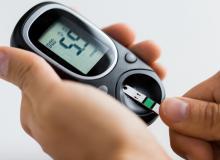Blood glucose monitoring is an important part of comprehensive diabetes management and one of the "five carriages" of diabetes treatment. It can determine the degree of glucose metabolism disorder, evaluate the effectiveness of lifestyle interventions including diet, exercise, and drug treatment, and is important for optimizing blood glucose management. , It is of great significance to formulate individualized treatment plans.
Blood glucose monitoring methods include blood glucose measurement, dynamic blood glucose monitoring, glycated hemoglobin, glycated serum albumin, etc. The above methods have different focuses and cannot be substituted for each other. Among them, point blood glucose measurements include intravenous blood glucose and rapid blood glucose measured by a portable blood glucose meter. The latter can often be performed by the patient at home, which is the so-called self-monitoring of blood glucose. According to the different time points of blood glucose measurement, it can be divided into fasting, 2 hours after a meal, before going to bed, night and random blood glucose, etc.
Self-monitoring of blood glucose is a common method of blood glucose management in patients with diabetes. Regular self-monitoring of blood glucose can help encourage patients to actively participate in diabetes management and provide a basis for medical staff to make clinical decisions. However, regardless of those "new sugars" who have just started to get sick, even many "old sugars" may have such confusion. Doctors usually ask patients to measure several fasting blood sugars and several postprandial blood sugars every week to observe themselves. blood sugar status, so which one is more important? First, let us understand what fasting blood glucose and 2-hour postprandial blood glucose are? Fasting blood sugar refers to the blood sugar value measured without eating for more than 8 hours. After breakfast, the blood sugar when the stomach has been emptied before lunch cannot be regarded as fasting blood sugar, but can only be called pre-meal blood sugar. In the same way, blood sugar before dinner cannot be regarded as fasting blood sugar. The 2-hour post-meal blood sugar refers to the blood sugar measured 2 hours after the first bite of the meal.
Fasting blood sugar is the starting point of blood sugar changes throughout the day and is closely related to postprandial blood sugar. Fasting blood glucose has a predictive effect on postprandial blood glucose levels and the extent of postprandial blood glucose excursions. However, there is increasing evidence that postprandial hyperglycemia is related to cardiovascular events and all-cause death. Monitoring postprandial blood sugar can not only understand the status of blood sugar control, but also play a role in preventing the occurrence of chronic complications of diabetes. Significance. Diabetic patients of different races have different manifestations of hyperglycemia. Research from Chinese people has found that in the early stages of diabetes, it often manifests as elevated postprandial blood sugar, while fasting blood sugar can mostly be within the normal range. In addition, the Chinese people's dietary structure is characterized by rice and noodles as staple foods, which are rich in carbohydrates, making them more prone to postprandial hyperglycemia.
It can be seen that fasting blood glucose and postprandial blood glucose have equal status in blood glucose monitoring. Measuring pre-meal blood sugar (including fasting blood sugar) is suitable when blood sugar levels are very high or there is a risk of hypoglycemia; post-meal blood sugar is suitable when fasting blood sugar is well controlled but glycated hemoglobin still cannot reach the target, or when it is necessary to understand the impact of diet and exercise on blood sugar. Influence. Reading the guide carefully, it is not difficult to find that in addition to the above-mentioned pre-meal blood sugar and post-meal blood sugar, self-blood sugar monitoring also includes bedtime blood sugar, nighttime blood sugar and random blood sugar. Bedtime blood sugar is suitable for those who are receiving insulin treatment, especially those who inject insulin before dinner; nighttime blood sugar is suitable for those who are under insulin treatment and their blood sugar is close to reaching the standard, but fasting blood sugar is still high or those who are suspected of having hypoglycemia at night; when symptoms of hypoglycemia occur or Before and after strenuous exercise, random blood sugar should be measured in time.
After understanding the significance of blood glucose monitoring at the above-mentioned different time points, I believe that the majority of diabetes lovers will have an idea. What is the relationship between fasting blood glucose, 2-hour postprandial blood glucose, and glycated hemoglobin? Glycated hemoglobin reflects the average blood sugar level 2 to 3 months before the blood draw, including both fasting blood sugar and 2-hour postprandial blood sugar. When glycated hemoglobin is not too high (9%), it is mainly affected by fasting blood sugar. Therefore, it is of great significance to guide patients to perform self-blood glucose monitoring correctly. When monitoring, you cannot monitor one measurement alone. Both fasting and postprandial blood glucose should be taken into consideration. At the same time, monitoring time points should be selected with emphasis based on the specific situation of the patient, which is the so-called individualized blood sugar monitoring, so that blood sugar can reach the standard as early as possible, continuously and stably.

